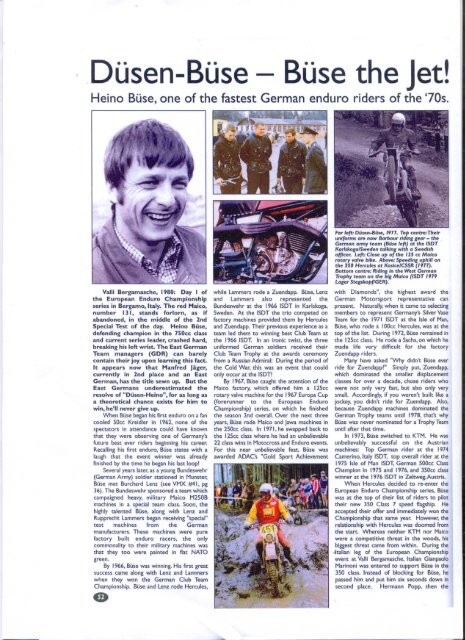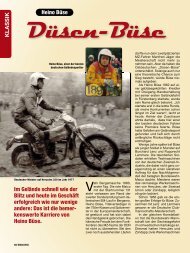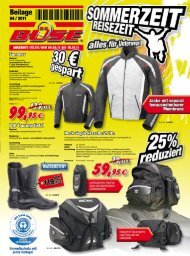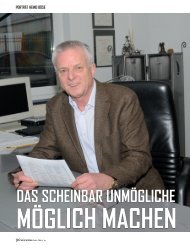Düsen-Büse - Büse the Jet!
Düsen-Büse - Büse the Jet!
Düsen-Büse - Büse the Jet!
You also want an ePaper? Increase the reach of your titles
YUMPU automatically turns print PDFs into web optimized ePapers that Google loves.
<strong>Düsen</strong>-<strong>Büse</strong> - <strong>Büse</strong> <strong>the</strong> <strong>Jet</strong>!<br />
Heino <strong>Büse</strong>, one of <strong>the</strong> fastest German enduro riders of <strong>the</strong> '70s.<br />
Valli Bergamasche, 1980: Oay I of<br />
<strong>the</strong> European Enduro Championship<br />
series in Bergamo, Italy, The red Maico,<br />
number 13 I, stands forlorn, as if<br />
abandoned, in <strong>the</strong> middle of <strong>the</strong> 2nd<br />
Special Test of <strong>the</strong> day. Heino <strong>Büse</strong>,<br />
defending champion in <strong>the</strong> 750cc dass<br />
and current se ries leader, crashed hard,<br />
breaking his left wrist. The East German<br />
Team managers (GOR) can barely<br />
contain <strong>the</strong>ir joy upon learning this fact.<br />
It appears now that Manfred Jäger,<br />
currently in 2nd place and an East<br />
German, has <strong>the</strong> title sewn up. But <strong>the</strong><br />
East Germans underestimated <strong>the</strong><br />
resolve of "Oüsen-Heino", for as long as<br />
a <strong>the</strong>oretical chance exists for hirn to<br />
win, he'lI never give up.<br />
When <strong>Büse</strong> began his first enduro on a fan<br />
cooled 50cc Kreidler in 1962, none of <strong>the</strong><br />
spectators in attendance could have known<br />
that <strong>the</strong>y were observing one of Germany's<br />
future best ever riders beginning his career.<br />
Recalling his first enduro, <strong>Büse</strong> states with a<br />
laugh that <strong>the</strong> event winner was al ready<br />
finished by <strong>the</strong> time he began his last loop!<br />
Several years later, as a young Bundeswehr<br />
(German Army) soldier stationed in Munster,<br />
<strong>Büse</strong> met Burchard Lenz (see VMX . #41, pg<br />
36). The Bundeswehr sponsored a team which<br />
campaigned heavy, military Maieo M2S0B<br />
machines in a special team dass. Soon, <strong>the</strong><br />
highly talented <strong>Büse</strong>, along with Lenz and<br />
Rupprecht Lammers began receiving "special"<br />
test machines from <strong>the</strong> German<br />
manufacturers. These machines .were pure<br />
factory built enduro racers, <strong>the</strong> only<br />
commonality to <strong>the</strong>ir military machines was<br />
that <strong>the</strong>y too were painted in flat NATO<br />
green.<br />
By 1966, <strong>Büse</strong> was winning. His first great<br />
success came along with Lenz and Lammers<br />
when <strong>the</strong>y won <strong>the</strong> German Club Team<br />
Championship. <strong>Büse</strong> and Lenz rode Hercules,<br />
while Lammers rode a Zuendapp. <strong>Büse</strong>, Lenz<br />
and Lammers also represented <strong>the</strong><br />
Bundeswehr at <strong>the</strong> 1966 ISDT in Karlskoga,<br />
Sweden. At <strong>the</strong> ISDT <strong>the</strong> trio competed on<br />
factory machines provided <strong>the</strong>m by Hercules<br />
and Zuendapp. Their previous experience as a<br />
team led <strong>the</strong>m to winning best Club Team at<br />
<strong>the</strong> 1966 ISDT. In an ironie twist, <strong>the</strong> three<br />
uniformed German soldiers received <strong>the</strong>ir<br />
Club Team Trophy at <strong>the</strong> awards ceremony<br />
from a Russian Admiral: During <strong>the</strong> period of<br />
<strong>the</strong> Cold War, this was an event that could<br />
only occur at <strong>the</strong> ISDT!<br />
By 1967, <strong>Büse</strong> caught <strong>the</strong> attention of <strong>the</strong><br />
Maieo factory, which offered him a 12Scc<br />
rotary valve machine for <strong>the</strong> 1967 Europa Cup<br />
(forerunner to <strong>the</strong> European Enduro<br />
Championship) series, on whieh he finished<br />
<strong>the</strong> season 2nd overall. Over <strong>the</strong> next three<br />
years, <strong>Büse</strong> rode Maico and Jawa machines in<br />
<strong>the</strong> 250cc dass. In 1971, he swapped back to<br />
<strong>the</strong> 125cc dass where he had an unbelievable<br />
22 dass wins in Motocross and Enduro events.<br />
For this near unbelievable feat, <strong>Büse</strong> was<br />
awarded ADAC's "Gold Sport Achievement<br />
Far left: <strong>Düsen</strong>-<strong>Büse</strong>, 1977. Top eentre:Their<br />
uniforms are now Barbour rlding gear - <strong>the</strong><br />
Gennan anny team (<strong>Büse</strong> left) at <strong>the</strong> ISDT<br />
KarlskogalSweden talking with a Swedish<br />
officer. Left: Clase up of <strong>the</strong> 12S ce Maico<br />
rotary valve bike. Above: Speeding uphill on<br />
<strong>the</strong> 350 Hercules at Kosice/CSSR (/977).<br />
Bottom centre: Riding in <strong>the</strong> West German<br />
Trophy team on <strong>the</strong> big Mako (ISDT /979<br />
Lager StegskopflGER).<br />
with Diamonds", <strong>the</strong> highest award <strong>the</strong><br />
German Motorsport representative can<br />
present. Naturally, when it came to selecting<br />
members to represent Germany's Silver Vase<br />
Team for <strong>the</strong> 1971 ISDT at <strong>the</strong> Isle of Man,<br />
<strong>Büse</strong>, who rode a 100cc Hercules, was at <strong>the</strong><br />
top of <strong>the</strong> list. During 1972, <strong>Büse</strong> remained in<br />
<strong>the</strong> 125cc dass. He rode a Sachs, on which he<br />
made life very difficult for <strong>the</strong> factory<br />
Zuendapp riders.<br />
Many have asked 'Why didn't <strong>Büse</strong> ever<br />
ride for Zuendapp?" Simply put, Zuendapp,<br />
which dominated <strong>the</strong> smaller displacement<br />
classes for over a decade, chose riders who<br />
were not only very fast, but also only very<br />
smalI. Accordingly, if you weren't built like a<br />
jockey, you didn't ride for Zuendapp. Also,<br />
because Zuendapp machines dominated <strong>the</strong><br />
German Trophy teams until 1978, that's why<br />
<strong>Büse</strong> was never nominated for a Trophy Team<br />
until after that time.<br />
In 1973, <strong>Büse</strong> switched to KTM. He was<br />
unbelievably successful on <strong>the</strong> Austrian<br />
machines: Top German rider at <strong>the</strong> 1974<br />
Camerino, ltaly ISDT, top overall rider at <strong>the</strong><br />
1975 Isle of Man ISDT, German 500cc Class<br />
Champion in 1975 and 1976, and 350cc dass<br />
winner at <strong>the</strong> 1976 ISDT in Zeltweg,Austria.<br />
When Hercules decided to re-enter <strong>the</strong><br />
European Enduro Championship se ries, <strong>Büse</strong><br />
was at <strong>the</strong> top of <strong>the</strong>ir list of riders to pilot<br />
<strong>the</strong>ir new 350 Class 7 speed flagship. He<br />
accepted <strong>the</strong>ir offer and immediately won <strong>the</strong><br />
Championship that same year. However, <strong>the</strong><br />
relationship with Hercules was doomed from<br />
<strong>the</strong> start. Whereas nei<strong>the</strong>r KTM nor Maico<br />
were a competitive threat in <strong>the</strong> woods, his<br />
biggest threat came from within. During <strong>the</strong><br />
talian leg of <strong>the</strong> European Championship<br />
event at Valli Bergamasche, ltalian Gianpaolo<br />
Marinoni was entered to support <strong>Büse</strong> in <strong>the</strong><br />
350 dass. Instead of blocking for <strong>Büse</strong>, he<br />
passed him and put him six seconds down in<br />
second place. Hermann Popp, <strong>the</strong>n <strong>the</strong>
Hercuies Team Manager, recalls: "The ltalian<br />
'Playmotor' Team also campaigned Hercules<br />
factory bikes, but <strong>the</strong>y were badged as export<br />
DKWs. Marinoni wasn't in <strong>the</strong> points hunt for<br />
<strong>the</strong> European Championship, yet he took this<br />
opportunity to make himself look good for <strong>the</strong><br />
ltalian press. However, if Marinoni's OKW<br />
would luve had a burned out taillight bulb, this<br />
would have cost him so many penalty points<br />
that he and <strong>Büse</strong> would have to swap Ist and<br />
2nd pi aces." Marinoni's teammates smelled a<br />
rat, and from <strong>the</strong>n on <strong>the</strong>y allowed no-one in<br />
<strong>the</strong> vicinity of his 350. The Hercules team had<br />
it all planned out from <strong>the</strong> start; <strong>the</strong>y planned<br />
to ride at Bergamo wearing red jerseys similar<br />
to <strong>the</strong> 'Playmotor' Team colors, in order to<br />
trick <strong>the</strong> ltalian spectators to think <strong>the</strong>y were<br />
ltalian riders and gain <strong>the</strong>ir support.<br />
By 1978, Hercules management wanted to<br />
foeus on winning a MX championship, and<br />
withdrEw <strong>the</strong>ir enduro teams from competition.<br />
The machines were competitive as reflected in<br />
<strong>the</strong> EL ropean Championships garnered by<br />
ltalians Perego and Gualdi. In spite of <strong>the</strong>ir<br />
successes, and <strong>the</strong> fact that <strong>the</strong> 1979 German<br />
ISDT would have made a great marketing<br />
opportunity for <strong>the</strong>ir enduro line, management<br />
decided to pull <strong>the</strong>ir support for <strong>the</strong>ir German<br />
and ltalian teams, and to cease enduro<br />
motorcycle production at <strong>the</strong> end of 1978.<br />
For 1979, Maico immediately stepped up<br />
and offered <strong>Büse</strong> a factory 250cc for <strong>the</strong><br />
German Championship, and a 504 ce for <strong>the</strong><br />
750 ce European Championship. And for <strong>the</strong><br />
first time, on German home ground, <strong>Büse</strong> was<br />
a member of <strong>the</strong> German Trophy Team at <strong>the</strong><br />
1979 ISOT in Lager Stegs kopf. He eouldn't<br />
have ended up having a better season at Maico:<br />
German 250ee Champion, European 750ec<br />
Champion, 750cc Class ISOT Champion, as<br />
weil as leading <strong>the</strong> German Trophy team to a<br />
second place finish, just behind <strong>the</strong> ltalians.<br />
In 1980, <strong>Büse</strong> intended to defend his<br />
European 750cc Title, but when it came to<br />
defend <strong>the</strong> German 250cc Championship, he<br />
was transferred by <strong>the</strong> factory into <strong>the</strong> 500cc<br />
class. This seemed to go weil for <strong>Büse</strong>. And<br />
<strong>the</strong>n came <strong>the</strong> shock at Bergamo. <strong>Büse</strong> had a<br />
comforcable lead over East German Jäger going<br />
into <strong>the</strong> 4th round in ltaly, but his personal ethic<br />
wouldn't allow him to ride a "safe race". Up<br />
until his stunning crash, <strong>Büse</strong> was bar to bar all<br />
day long, battling with ltalian SWM rider<br />
Guglielmo Andreini for <strong>the</strong> overall. The ltalian<br />
spectators were stunned at <strong>the</strong> ferocity of <strong>the</strong>ir<br />
competition, but for <strong>Büse</strong>, it appeared that <strong>the</strong><br />
European Championship was all but lost.<br />
Yet, an even greater surprise was in store<br />
for <strong>the</strong> MZ Team, when <strong>Büse</strong> showed up three<br />
weeks later at <strong>the</strong> Austrian event at<br />
Neumarke. ready to race. The MZ appeals fell<br />
on deaf ears, because <strong>Büse</strong> had supplied <strong>the</strong><br />
race officials with a letter from <strong>the</strong> famed<br />
Belgian surgeon Or. Joan Oerweduwen,<br />
clearing him to race. After he finished in<br />
second place behind Jäger, <strong>the</strong> East German<br />
press reported that Maico had "bought" all <strong>the</strong><br />
riders in <strong>the</strong> 750cc dass,so that <strong>Büse</strong> wouldn't<br />
lose any points. According to an East German<br />
. Top left: Fighting (or seconds in <strong>the</strong> special<br />
test. Top centre: Ridlng <strong>the</strong> 500 cc Mako to<br />
w;n <strong>the</strong> Germon championship in 1980. Above:<br />
The way ISDT winners troveled ;n <strong>the</strong> Sixties:<br />
(octory bikes on 0 trailer, pulied by 0 Glas<br />
compact car. Far left: Top rider on Hercules'<br />
new flogship - <strong>the</strong> GS 350 7 speed (1977).<br />
Left: Comeback with 0 broken wrist in<br />
NeumarktlAustria to de(end <strong>the</strong> title. Bottom<br />
centre: Servicing his Maico 1980.<br />
newspaper, "Sports equality is also a<br />
purchaseable commodity in <strong>the</strong> eapitalist<br />
economy." r,:Ne muse. however, remember<br />
that this exchange occurred in <strong>the</strong> middle of<br />
<strong>the</strong> Cold War, and motoreycle raeing.<br />
especially enduros and <strong>the</strong> ISOT, were <strong>the</strong><br />
front lines of this war between West and East.)<br />
<strong>Büse</strong> was eventually able to keep Jäger at a<br />
distanee to win <strong>the</strong> final ever European 750ee<br />
class Championship, as weil as <strong>the</strong> German<br />
SOOee Championship.<br />
After winning <strong>the</strong> 1982 500ec German<br />
Championship again, <strong>Büse</strong> hung up his heimet<br />
and walked away from racing. Maico<br />
production machine quality control difficulties<br />
had placed <strong>the</strong> company in such a perilous<br />
financial position that <strong>the</strong> Swabian motorcycle<br />
eompany was foreed to eease production and<br />
close <strong>the</strong>ir doors.<br />
Heino <strong>Büse</strong> was <strong>the</strong>n 39 years old. He<br />
ended his eareer in <strong>the</strong> same manner that he<br />
eompeted. "I just didn't see a chance to get a<br />
eompetitive maehine anymore" he reealls<br />
today. And raeing for 2nd plaee has never<br />
been his motto. <strong>Büse</strong> has won six German<br />
Enduro Championships on KTM, Hercules,<br />
and Maico, twO European Championships on<br />
Maico, twelve ISOT Gold Medals, <strong>the</strong> Overall<br />
at <strong>the</strong> 50th ISOT at <strong>the</strong> Isle of Man in 1975,<br />
in addition to innumerable local MX and<br />
Enduro events. There has never been any<br />
doubt that <strong>Büse</strong> hasn't earned his nickname<br />
of "<strong>Büse</strong> <strong>the</strong> <strong>Jet</strong>"!<br />
Once retired from racing, <strong>Büse</strong> used his<br />
contacts within <strong>the</strong> racing community to<br />
create one of <strong>the</strong> largest motorcycle racing<br />
and accessory companies in Europe. From a<br />
"one man shop" where he sold high quality<br />
racing gear to his former competitors, <strong>Büse</strong><br />
now supplies over 3000 dealers in Europe<br />
with products bearing his name.<br />
Words by Leo Keller<br />
Photos (rom Heino <strong>Büse</strong>, Lenz, KTM,<br />
Zweirad Union archive






